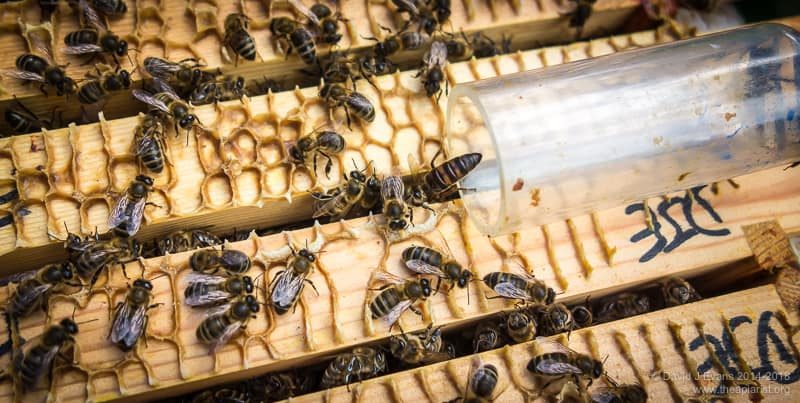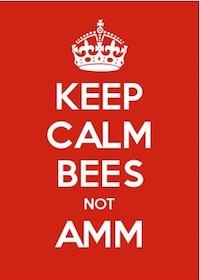Keep Calm and Have Patience
Around this time of the season§ the discussion forums are awash with questions about virgin queens failing to emerge, or get out to mate, or return from mating flights, or start laying eggs, or any of a myriad of other possible things that can go wrong between a sealed queen cell and a nicely laying queen.
Or where to buy a new queen for a terminally queenless colony.
Followed a week later by a question about what to do with a recently purchased, and soon to be delivered, queen that is now surplus to requirement as – miraculously – a beautiful mated and laying queen is now obviously present and busy in the hive 😉
Practice makes perfect
There’s good evidence from recent genetic studies that the honey bee (Apis mellifera) evolved about 300,000 years ago from Asian cavity-nesting bees†. This was determined by analysing 140 bees sampled from around the world. The genetic differences between them (over 8.3 million in total) were identified and then – knowing the rate at which differences arise – it was possible to extrapolate backwards to define the approximate time the first honey bee (Eve?) evolved.
For comparison, humans – modern man, Homo sapiens – have been around for about the same length of time‡.
Coincidence? Probably.
300,000 years is a long time when compared to the lifespan of a human, or a bee. However, it’s a mere blink of an eye in evolutionary terms. It also means that bees, and humans, are relatively recent arrivals when compared with fig wasps (34 million years), coelacanths (65 million years) or elephant sharks (420 million years).
Nevertheless, although bees might be evolutionary newcomers, they have been getting it right for about 300,000 years. Which means they’ve been superceding and swarming ever since modern man was recognisably modern man.
Which means they’re reasonably good at it … ‘it’ being reproduction∞, and more specifically getting the queen mated.
If they weren’t any good at it they’d be long gone by now.
Going by the book
The development of the queen takes 16 days from egg to eclosed (emerged) virgin. Three days as an egg, a further 6 days as a larva at which point the cell is sealed. Pupation then lasts for a further 7 days. The recently emerged queen needs to become sexually mature. This process takes a further 5 to 6 days before she goes on one (or more) matings flight(s). After mating she then returns to the hive and, after a further 2-3 days, starts laying eggs.
So, under optimal conditions, it takes a minimum of ~23-25 days to go from egg to mated and laying queen i.e. about three and a half weeks.
If a queen is removed from the hive, deliberately or by accident, there could be a new, mated laying queen present about three and a half weeks later.
In fact, it’s possible the new queen could be mated and laying in less time than this. The queenless colony might start to rear young larvae as queens, so ‘saving’ a few days. It’s generally reckoned that larvae up to about three days old can be selected by the colony and reared as queens, though younger is better as they are better fed for longer.
Bees can’t read
However, things rarely go by the book. Although development time is pretty-much fixed at 16 days from newly laid egg to emerged virgin, there’s plenty of opportunity to lengthen (and rarely shorten, as outlined above) the time taken before the queen starts laying.
Chief amongst these is getting conditions suitable for queen mating. Typically this needs to be warm and settled weather. High teens centigrade, sunny and light winds between late morning and mid/late afternoon. If this doesn’t occur the queen stays put in the hive.
There’s also a time window within which successful mating must occur. This starts when the queen reaches sexual maturity (~5-6 days after emergence) and ends three to four weeks later (~26-33 days after emergence). A few days of poor weather during this period may well delay mating. Three weeks of lousy weather can be catastrophic – she may well turn out to be poorly mated or, if she doesn’t mate, a drone laying queen.
Depending on where you live, it’s rare to get three continuous weeks of terrible weather during the predominant swarming period (late April to late-July perhaps). However, it’s not uncommon to get a week or so of ‘unseasonable’ weather∑. In 2017, June was the wettest on record in Fife – precisely when I expected my virgins to be going out to mate.
Keep calm and Have Patience

Keep Calm …
All this means is that you need patience when waiting for newly mated and laying queens in your colonies. In my experience it usually takes longer than it could, and it’s almost always longer than I want.
You should be able to calculate when the virgin queen will emerge to within a day or so of the colony becoming queenless. Better still, judge the development of queen cells and add 7 days to the date on which the cell become capped.
I usually check to make sure there’s a virgin queen in the hive. They’re small, skittish and often tricky to spot. They don’t get the same sort of attention from the workers as a mated queen gets. They can fly, and do if you disturb them too much. It’s reassuring to know there’s an emerged virgin present, but don’t keep checking. I try and check on the day after emergence. If you check too late and the weather is good there’s a chance you’ll interrupt her returning from a mating flight, with possibly disastrous consequences.
Then wait.
Observe the bees at the hive entrance and look for them returning laden with pollen. If you must inspect the colony (why?) do so early or late in the day. Don’t bother looking for the queen. Instead look for polished cells in the middle of the central frames … and eggs of course.
Dates from my diary
In June 2017 new queens should have emerged from my vertical splits on or shortly after the 2nd. Under optimal conditions I could hope these virgins would be mated and laying by the 12th at the latest. The splits were all set up on the same day. I didn’t check every hive for the presence of a virgin, and didn’t find one in every hive I checked, but I did find the expected vacated queen cell.
It then started raining. Lots. One of my apiaries flooded.
I had a quick look on the 12th in a couple of hives – no eggs. I checked again around the 22nd. The 18th had near-perfect weather for queen mating – sunny, 20+°C, light winds – and found mated, laying queens in a couple of boxes. But not in all of them. It wasn’t until the 27th that I found evidence that the latest queen was mated and laying well. She’d obviously started a day or so earlier as there were already eggs across two full frames.
All but two splits appears to have been successful – defined by presence of a laying queen∏. None were mated and laying anywhere near the minimal possible 9-10 days after emergence. One developed laying workers and I suspect the queen got lost on a mating flight quite early on. The second looks promising and I’ve not yet given up hope on this remaining colony.
I don’t keep records of the time it takes for new queens to get mated. However, from emergence (the date of which I usually do know) I wouldn’t be surprised if the average was a little over 21 days.
The shortest mating times I’ve seen occur in ideal weather conditions when using mini-nucs for queen rearing – under these circumstances ~11-12 days is not uncommon. But that’s a post for the future …
Keep Calm and Carry On
§ This was written in mid/late June in Fife, Scotland … about two weeks after the peak of the swarm season.
† Wallberg et al., A worldwide survey of genome sequence variation provides insight into the evolutionary history of the honeybee Apis mellifera. Nature Genetics, 2014; DOI: 10.1038/NG.3077
‡ Huber et al., New fossils from Jebel Irhoud, Morocco and the pan-African origin of Homo sapiens. Nature, 2017; DOI:10.1038/nature22336
∞ OK … formally, I know that supercedure might not be considered as ‘reproduction’.
∑ Though how it can be considered unseasonable when it’s not uncommon is a mystery 😉
∏ Of course, the true measure of success when rearing new queens is much more rigorous than this. They need to primarily lay fertilised worker eggs, have a tight laying pattern, mother well-behaved, calm bees that work well in the local environment, do not have a tendency to swarm, are frugal with winter stores and build up well in early Spring. And the rest …
Colophon
Keep Calm and Carry On was the text on a motivational poster produced in 1939 in the run up to World War II. Millions of copies were printed but few were ever displayed … in fact, many were pulped in 1940 to help overcome a serious paper shortage.
There’s an excellent account of the history and (many) compromises made during the design and preparation of the poster (almost 78 years to the day I’m writing this) on the Government history blog – highly recommended.
The poster was largely forgotten until 2000 when it was re-discovered. The rest, as they say, is history … it’s now ubiquitous, corrupted in a load of different ways and used on all sorts of novelty and decorative products.
You can even design your own …






Join the discussion ...